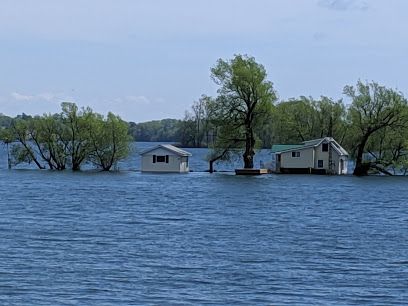As a teenager, my son had a saying, whether original or borrowed I don’t know (the saying, that is), which went something like “All things in moderation. Especially moderation.” It would seem Mother Nature took that to heart, and dispensed with moderate rainfall and snow melt this past spring. If not her, then maybe it was Creepy Uncle Climate Change. At any rate, the resultant flooding has been heartbreaking to observe.

While I am, of course, sensitive to the anguish of those people affected by the record-high waters, as an arborist I cannot help but think about the suffering trees as well.
Flood water impacts trees in many ways, one of which would be literal impacts, such as when objects entrained in flowing water scrape against tree trunks. That kind of injury is obvious, as well as relatively uncommon and typically not too severe. What really harms trees is a shortage of oxygen in flooded soils.
Soil pores are what allow oxygen to passively reach tree roots. This is the main reason tree roots are so shallow: 90% in the top 25 centimetres (10 inches) and 98% in the top 46 cm (18 in). It is also why adding fill to raise the grade over a tree’s root zone causes stress, and often leads to the tree’s decline starting 2-5 years later. Very few tree species are adapted to extreme low-oxygen conditions.
Many of us have seen photos of the semi-tropical baldcypress happily growing in swamps. Baldcypress have evolved structures called pneumatophores which enable them to channel air to their roots so they don’t suffocate. But our trees have no such adaptations, and can’t hold their breath for long.
The extent of root damage wrought by flooding depends on many factors, such as time of year. In the dormant season, soils are cool, and root-respiration rates are commensurately low. This means roots can forgo oxygen longer. Severity of flood damage also depends on a tree’s health before the event.
Soil type makes a difference. If a site is sandy, it will drain faster once the water recedes, as compared to a heavy soil. Sand also naturally allows oxygen in more easily. Trees on clay or silt soils will be more acutely stressed.

The length of time roots are under water is critical as well. Two or three days may not cause undue harm, but if it goes a week or more, most species will suffer grave injury. In part, flood tolerance depends on genetics – some species can survive inundation better than others.
In cases of a week or more of flooding, trees like red maple (Acer rubrum) and silver maple (A. saccharinum) fare better than sugar maple (A. saccharum), for example. River birch (Betula nigra) will suffer less than paper birch (B. papyrifera). Pin oak (Quercus palustris) can handle saturated conditions much better than red oak (Q. rubra). Eastern cottonwood (Populus deltoides) is another tree that can hold its water. Black tupelo, also called black or sour gum (Nyssa sylvatica) is fine with a couple weeks of water-soaked roots. Willows (Salix spp.), American larch (Larix laricina), balsam fir (Abies balsamea), and northern catalpa (Catalpa speciosa) are other flood-tolerant trees.
Shrubs that can withstand high water include American elderberry (Sambucus canadensis), winterberry holly (Ilex verticillata), chokeberry (Aronia spp.), highbush cranberry (Vburnum trilobum), and native shrub-dogwood species (Cornus spp.).

However, hickories (Carya spp.), black locust (Robinia pseudoacacia), linden (Tilia spp.), black walnut (Juglans nigra), eastern redbud (Cercis canadensis), Colorado spruce (Picea pungens), as well as all fruit trees, are more likely to come to harm when surrounded by water for a week.
Symptoms of flood stress include chlorotic, wilting, undersize, or curling leaves, a sparse crown, early fall color (as compared to others of its species), and branch-tip dieback. Depending on all the factors discussed above, symptoms may occur the first season, or they may take several years to manifest.
After things dried up in August, most people affected by this year’s flood were understandably busy with more pressing things. When the time comes to think about the trees, one of the more important ways one can help them is to avoid causing further harm. This is a key point. Do not park, drive, or stage materials within the root zone, which is two times the branch length. After having been submerged, a tree’s root zone is vulnerable even to modest activity, which in such conditions can destroy soil structure and compound tree stress exponentially.
You can hire an ISA Certified Arborist to assess the tree, and also to potentially aerate the root zone through pneumatic soil fracturing, vertical mulching, or other treatments.

To find a Certified Arborist near you, visit https://www.treesaregood.org/findanarborist/findanarborist
I wish all the best to those suffering from high waters. May you and I have a more moderate spring 2020.
By Paul Hetzler
Paul Hetzler has been an ISA Certified Arborist since 1996, and is a member of ISA-Ontario, the Canadian Society of Environmental Biologists, the Canadian Institute of Forestry, and the Society of American Foresters.
The author, Paul Hetzler suggested each camption could read, "Trees can't hold their breath for very long..." Thanks to Ken White and Dennis McCarthy for providing photographs of flooded properties.
Posted in: Volume 14, Issue 10, October 2019, Nature
Please click here if you are unable to post your comment.
